Anmol Agarwal
Voxtral
Jul 17, 2025Abstract:We present Voxtral Mini and Voxtral Small, two multimodal audio chat models. Voxtral is trained to comprehend both spoken audio and text documents, achieving state-of-the-art performance across a diverse range of audio benchmarks, while preserving strong text capabilities. Voxtral Small outperforms a number of closed-source models, while being small enough to run locally. A 32K context window enables the model to handle audio files up to 40 minutes in duration and long multi-turn conversations. We also contribute three benchmarks for evaluating speech understanding models on knowledge and trivia. Both Voxtral models are released under Apache 2.0 license.
Magistral
Jun 12, 2025



Abstract:We introduce Magistral, Mistral's first reasoning model and our own scalable reinforcement learning (RL) pipeline. Instead of relying on existing implementations and RL traces distilled from prior models, we follow a ground up approach, relying solely on our own models and infrastructure. Notably, we demonstrate a stack that enabled us to explore the limits of pure RL training of LLMs, present a simple method to force the reasoning language of the model, and show that RL on text data alone maintains most of the initial checkpoint's capabilities. We find that RL on text maintains or improves multimodal understanding, instruction following and function calling. We present Magistral Medium, trained for reasoning on top of Mistral Medium 3 with RL alone, and we open-source Magistral Small (Apache 2.0) which further includes cold-start data from Magistral Medium.
Metron: Holistic Performance Evaluation Framework for LLM Inference Systems
Jul 09, 2024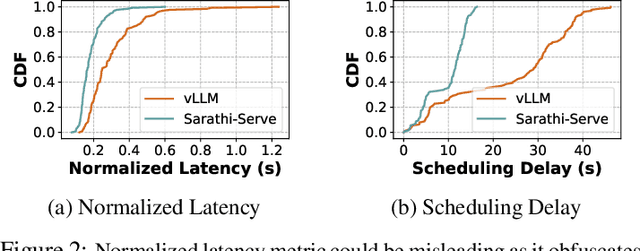

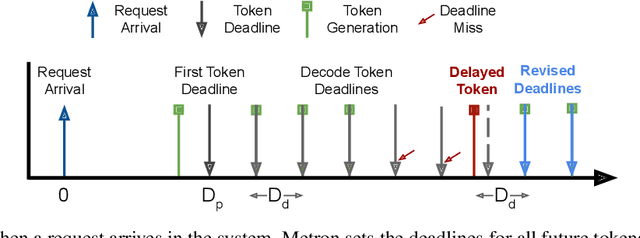
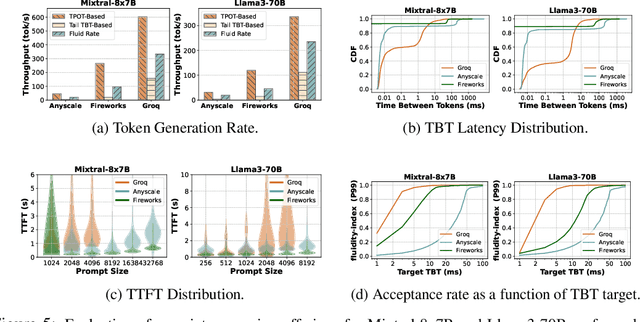
Abstract:Serving large language models (LLMs) in production can incur substantial costs, which has prompted recent advances in inference system optimizations. Today, these systems are evaluated against conventional latency and throughput metrics (eg. TTFT, TBT, Normalised Latency and TPOT). However, these metrics fail to fully capture the nuances of LLM inference, leading to an incomplete assessment of user-facing performance crucial for real-time applications such as chat and translation. In this paper, we first identify the pitfalls of current performance metrics in evaluating LLM inference systems. We then propose Metron, a comprehensive performance evaluation framework that includes fluidity-index -- a novel metric designed to reflect the intricacies of the LLM inference process and its impact on real-time user experience. Finally, we evaluate various existing open-source platforms and model-as-a-service offerings using Metron, discussing their strengths and weaknesses. Metron is available at https://github.com/project-metron/metron.
Class-Level Code Generation from Natural Language Using Iterative, Tool-Enhanced Reasoning over Repository
Apr 22, 2024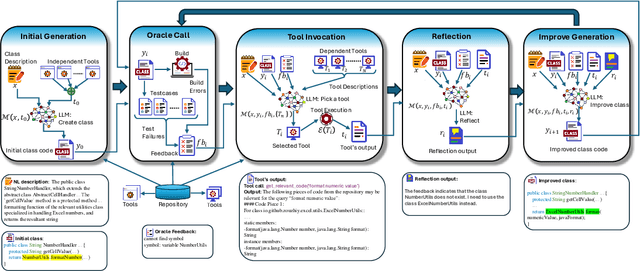
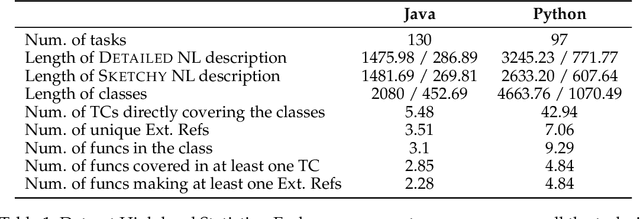

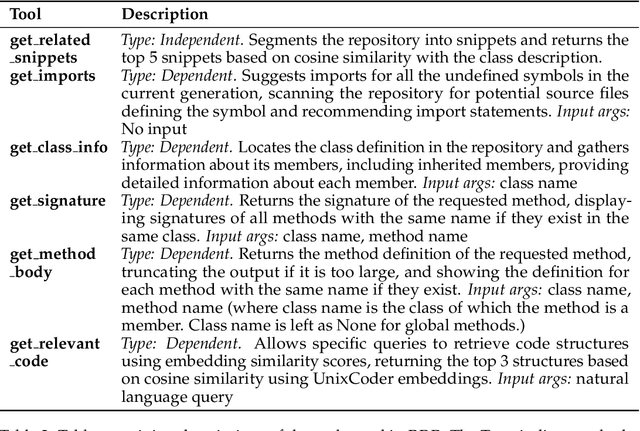
Abstract:LLMs have demonstrated significant potential in code generation tasks, achieving promising results at the function or statement level in various benchmarks. However, the complexities associated with creating code artifacts like classes, particularly within the context of real-world software repositories, remain underexplored. Existing research often treats class-level generation as an isolated task, neglecting the intricate dependencies and interactions that characterize real-world software development environments. To address this gap, we introduce RepoClassBench, a benchmark designed to rigorously evaluate LLMs in generating complex, class-level code within real-world repositories. RepoClassBench includes natural language to class generation tasks across Java and Python, from a selection of public repositories. We ensure that each class in our dataset not only has cross-file dependencies within the repository but also includes corresponding test cases to verify its functionality. We find that current models struggle with the realistic challenges posed by our benchmark, primarily due to their limited exposure to relevant repository contexts. To address this shortcoming, we introduce Retrieve-Repotools-Reflect (RRR), a novel approach that equips LLMs with static analysis tools to iteratively navigate & reason about repository-level context in an agent-based framework. Our experiments demonstrate that RRR significantly outperforms existing baselines on RepoClassBench, showcasing its effectiveness across programming languages and in various settings. Our findings emphasize the need for benchmarks that incorporate repository-level dependencies to more accurately reflect the complexities of software development. Our work illustrates the benefits of leveraging specialized tools to enhance LLMs understanding of repository context. We plan to make our dataset and evaluation harness public.
ChaTA: Towards an Intelligent Question-Answer Teaching Assistant using Open-Source LLMs
Nov 13, 2023Abstract:Responding to the thousands of student questions on online QA platforms each semester has a considerable human cost, particularly in computing courses with rapidly growing enrollments. To address the challenges of scalable and intelligent question-answering (QA), we introduce an innovative solution that leverages open-source Large Language Models (LLMs) from the LLaMA-2 family to ensure data privacy. Our approach combines augmentation techniques such as retrieval augmented generation (RAG), supervised fine-tuning (SFT), and learning from human preferences data using Direct Preference Optimization (DPO). Through extensive experimentation on a Piazza dataset from an introductory CS course, comprising 10,000 QA pairs and 1,500 pairs of preference data, we demonstrate a significant 30% improvement in the quality of answers, with RAG being a particularly impactful addition. Our contributions include the development of a novel architecture for educational QA, extensive evaluations of LLM performance utilizing both human assessments and LLM-based metrics, and insights into the challenges and future directions of educational data processing. This work paves the way for the development of CHATA, an intelligent QA assistant customizable for courses with an online QA platform
* Updates for camera-ready submission
Towards Effective Paraphrasing for Information Disguise
Nov 08, 2023Abstract:Information Disguise (ID), a part of computational ethics in Natural Language Processing (NLP), is concerned with best practices of textual paraphrasing to prevent the non-consensual use of authors' posts on the Internet. Research on ID becomes important when authors' written online communication pertains to sensitive domains, e.g., mental health. Over time, researchers have utilized AI-based automated word spinners (e.g., SpinRewriter, WordAI) for paraphrasing content. However, these tools fail to satisfy the purpose of ID as their paraphrased content still leads to the source when queried on search engines. There is limited prior work on judging the effectiveness of paraphrasing methods for ID on search engines or their proxies, neural retriever (NeurIR) models. We propose a framework where, for a given sentence from an author's post, we perform iterative perturbation on the sentence in the direction of paraphrasing with an attempt to confuse the search mechanism of a NeurIR system when the sentence is queried on it. Our experiments involve the subreddit 'r/AmItheAsshole' as the source of public content and Dense Passage Retriever as a NeurIR system-based proxy for search engines. Our work introduces a novel method of phrase-importance rankings using perplexity scores and involves multi-level phrase substitutions via beam search. Our multi-phrase substitution scheme succeeds in disguising sentences 82% of the time and hence takes an essential step towards enabling researchers to disguise sensitive content effectively before making it public. We also release the code of our approach.
* Accepted at ECIR 2023
Instance-Level Semantic Maps for Vision Language Navigation
May 23, 2023Abstract:Humans have a natural ability to perform semantic associations with the surrounding objects in the environment. This allows them to create a mental map of the environment which helps them to navigate on-demand when given a linguistic instruction. A natural goal in Vision Language Navigation (VLN) research is to impart autonomous agents with similar capabilities. Recently introduced VL Maps \cite{huang23vlmaps} take a step towards this goal by creating a semantic spatial map representation of the environment without any labelled data. However, their representations are limited for practical applicability as they do not distinguish between different instances of the same object. In this work, we address this limitation by integrating instance-level information into spatial map representation using a community detection algorithm and by utilizing word ontology learned by large language models (LLMs) to perform open-set semantic associations in the mapping representation. The resulting map representation improves the navigation performance by two-fold (233\%) on realistic language commands with instance-specific descriptions compared to VL Maps. We validate the practicality and effectiveness of our approach through extensive qualitative and quantitative experiments.
CST5: Data Augmentation for Code-Switched Semantic Parsing
Nov 14, 2022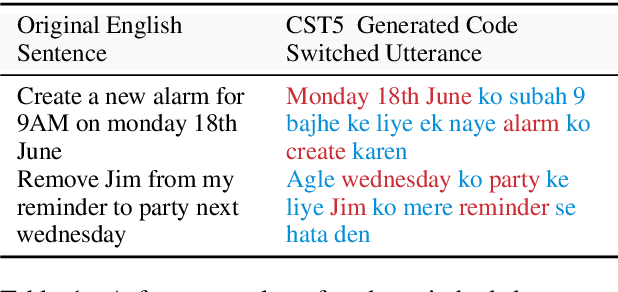
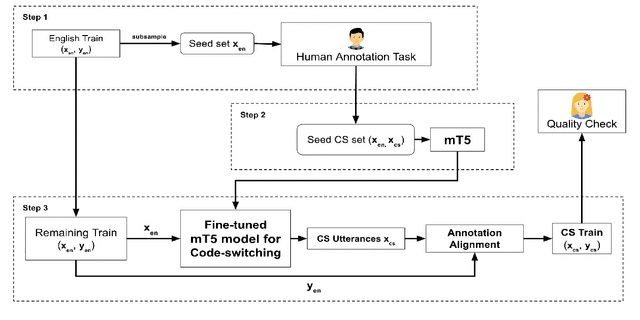
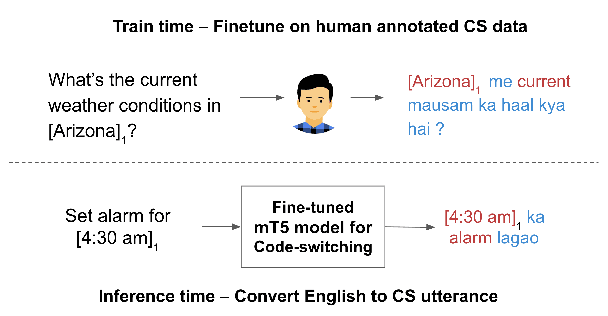
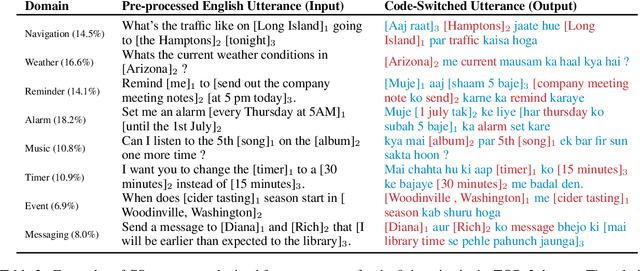
Abstract:Extending semantic parsers to code-switched input has been a challenging problem, primarily due to a lack of supervised training data. In this work, we introduce CST5, a new data augmentation technique that finetunes a T5 model using a small seed set ($\approx$100 utterances) to generate code-switched utterances from English utterances. We show that CST5 generates high quality code-switched data, both intrinsically (per human evaluation) and extrinsically by comparing baseline models which are trained without data augmentation to models which are trained with augmented data. Empirically we observe that using CST5, one can achieve the same semantic parsing performance by using up to 20x less labeled data. To aid further research in this area, we are also releasing (a) Hinglish-TOP, the largest human annotated code-switched semantic parsing dataset to date, containing 10k human annotated Hindi-English (Hinglish) code-switched utterances, and (b) Over 170K CST5 generated code-switched utterances from the TOPv2 dataset. Human evaluation shows that both the human annotated data as well as the CST5 generated data is of good quality.
Learning to Automate Follow-up Question Generation using Process Knowledge for Depression Triage on Reddit Posts
May 27, 2022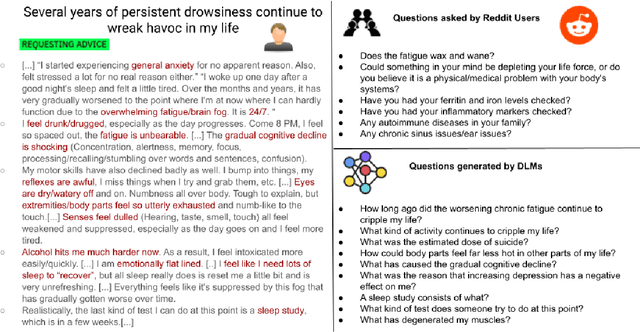
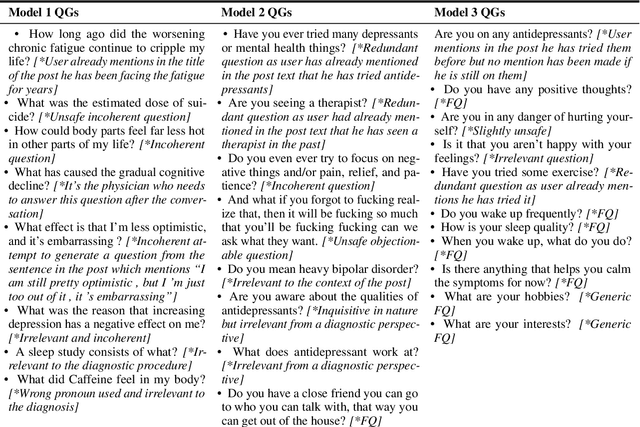

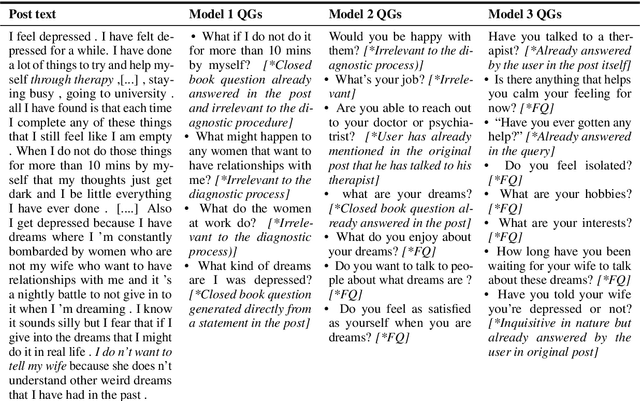
Abstract:Conversational Agents (CAs) powered with deep language models (DLMs) have shown tremendous promise in the domain of mental health. Prominently, the CAs have been used to provide informational or therapeutic services to patients. However, the utility of CAs to assist in mental health triaging has not been explored in the existing work as it requires a controlled generation of follow-up questions (FQs), which are often initiated and guided by the mental health professionals (MHPs) in clinical settings. In the context of depression, our experiments show that DLMs coupled with process knowledge in a mental health questionnaire generate 12.54% and 9.37% better FQs based on similarity and longest common subsequence matches to questions in the PHQ-9 dataset respectively, when compared with DLMs without process knowledge support. Despite coupling with process knowledge, we find that DLMs are still prone to hallucination, i.e., generating redundant, irrelevant, and unsafe FQs. We demonstrate the challenge of using existing datasets to train a DLM for generating FQs that adhere to clinical process knowledge. To address this limitation, we prepared an extended PHQ-9 based dataset, PRIMATE, in collaboration with MHPs. PRIMATE contains annotations regarding whether a particular question in the PHQ-9 dataset has already been answered in the user's initial description of the mental health condition. We used PRIMATE to train a DLM in a supervised setting to identify which of the PHQ-9 questions can be answered directly from the user's post and which ones would require more information from the user. Using performance analysis based on MCC scores, we show that PRIMATE is appropriate for identifying questions in PHQ-9 that could guide generative DLMs towards controlled FQ generation suitable for aiding triaging. Dataset created as a part of this research: https://github.com/primate-mh/Primate2022
Diagnosing Web Data of ICTs to Provide Focused Assistance in Agricultural Adoptions
Oct 29, 2021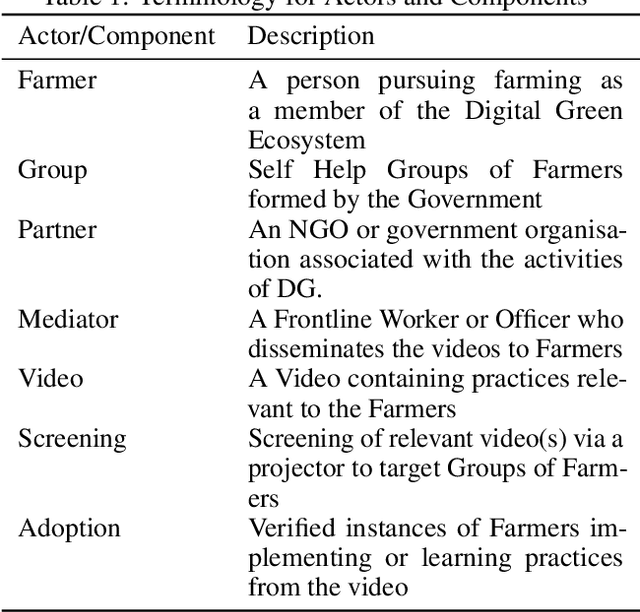
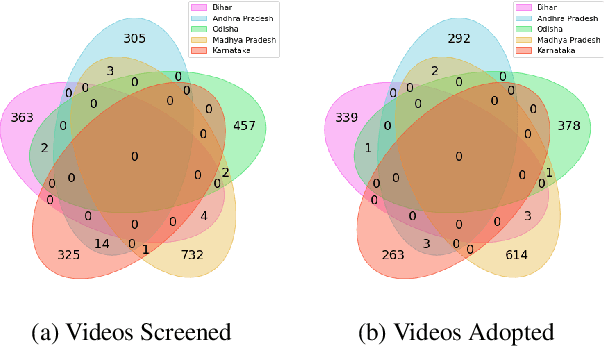

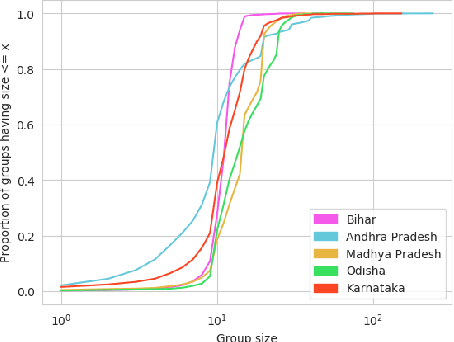
Abstract:The past decade has witnessed a rapid increase in technology ownership across rural areas of India, signifying the potential for ICT initiatives to empower rural households. In our work, we focus on the web infrastructure of one such ICT - Digital Green that started in 2008. Following a participatory approach for content production, Digital Green disseminates instructional agricultural videos to smallholder farmers via human mediators to improve the adoption of farming practices. Their web-based data tracker, CoCo, captures data related to these processes, storing the attendance and adoption logs of over 2.3 million farmers across three continents and twelve countries. Using this data, we model the components of the Digital Green ecosystem involving the past attendance-adoption behaviours of farmers, the content of the videos screened to them and their demographic features across five states in India. We use statistical tests to identify different factors which distinguish farmers with higher adoption rates to understand why they adopt more than others. Our research finds that farmers with higher adoption rates adopt videos of shorter duration and belong to smaller villages. The co-attendance and co-adoption networks of farmers indicate that they greatly benefit from past adopters of a video from their village and group when it comes to adopting practices from the same video. Following our analysis, we model the adoption of practices from a video as a prediction problem to identify and assist farmers who might face challenges in adoption in each of the five states. We experiment with different model architectures and achieve macro-f1 scores ranging from 79% to 89% using a Random Forest classifier. Finally, we measure the importance of different features using SHAP values and provide implications for improving the adoption rates of nearly a million farmers across five states in India.
 Add to Chrome
Add to Chrome Add to Firefox
Add to Firefox Add to Edge
Add to Edge